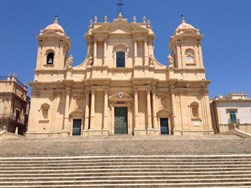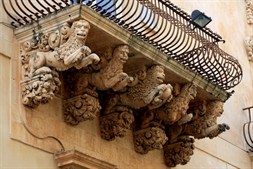Noto
Even more than Catania, Syracuse or Modica, Noto is the Sicilian town that more than any other owes its fame to Baroque reconstruction after the earthquake of 1693. Declared a UNESCO World Heritage Site, the current Noto is, in reality, 8 kilometres south of old Noto, whose ancient history was wiped out by the earthquake at the end of their seventeenth century. The Duke of CamastraPalermo-born Giuseppe Lanza, the Duke of Camastra (1630-1708) was a magistrate and very close to the Spanish power. The viceroy, the Duke of Uceda himself asked him to organize and lead the reconstruction phase of Catania and the whole of south-eastern Sicily after the devastating earthquake of 1693., in charge of the reconstruction, then decided to move the urban core further away and in the following decades various architects, engineers and artists worked on the creation of the extraordinary city centre.
 There are many testimonies of the Baroque of Noto dating back to those years of fervent reconstruction. Among them is the Cathedral of San Nicola (Saint Nicholas), the seat of the Diocese of Noto. Construction work began in 1694 and ended just nine years later, in 1703, although several changes were added over the following centuries. The façade is in limestone and it is a classic example of late-Baroque style in Sicily which has French and Neoclassic influences. On the top of the staircase which rises up to three flights there is a façade with side towers with three portals between Corinthian columns and in the second order, four statues representing the evangelists and a central window. The interior has three naves and houses various works of art, some from old Noto, and the urn that holds the remains of Corrado ConfalonieriCorrado Confalonieri (1290-1351) was a Franciscan tertiary, pilgrim, penitent and hermit. The Catholic Church celebrates his memory on 19 February.. In March 1996, certain construction defects caused the collapse of the dome of the right aisle of the nave and the transept. The cathedral was rebuilt following the original model, and reopened to the public in 2007, with the addition of some valuable works of contemporary art.
There are many testimonies of the Baroque of Noto dating back to those years of fervent reconstruction. Among them is the Cathedral of San Nicola (Saint Nicholas), the seat of the Diocese of Noto. Construction work began in 1694 and ended just nine years later, in 1703, although several changes were added over the following centuries. The façade is in limestone and it is a classic example of late-Baroque style in Sicily which has French and Neoclassic influences. On the top of the staircase which rises up to three flights there is a façade with side towers with three portals between Corinthian columns and in the second order, four statues representing the evangelists and a central window. The interior has three naves and houses various works of art, some from old Noto, and the urn that holds the remains of Corrado ConfalonieriCorrado Confalonieri (1290-1351) was a Franciscan tertiary, pilgrim, penitent and hermit. The Catholic Church celebrates his memory on 19 February.. In March 1996, certain construction defects caused the collapse of the dome of the right aisle of the nave and the transept. The cathedral was rebuilt following the original model, and reopened to the public in 2007, with the addition of some valuable works of contemporary art.
 As an example of civil architecture there is Palazzo Nicolaci di Villadorata, located in the same street, via Nicolaci, where every year the infiorataEvery year the city of Noto celebrates the infiorata on the third Sunday of May. The festival is held in via Nicolaci, which is covered with a carpet of flowers arranged to create wonderful designs, according to the different theme chosen each year. Local artists flock to the city for the event, but also, especially in recent years, international artists. takes place. The construction began around 1720 and continued until 1765. The Baroque façade has a portal with two large Ionic columns at the sides. Above the portal stands a spectacular balcony, flanked by six other smaller balconies, three on each side, which are among the most famous images of the Sicilian Baroque. All the balconies have curved railings in wrought iron and are supported by corbels which are all different from each other, with the appearance of children, animals and mythological creatures such as centaurs and mermaids. The building, born as a urban residence of the noble Nicolaci family (which is still the owner of a wing of the building, while the rest was donated to the town of Noto), has 90 rooms spread over four floors. Among them are the richly decorated Salone Giallo (Yellow Room), where the Nicolaci family used to listen to music and private concerts, the Salone Verde (Green Room), where guests were received, and the Salone delle feste (Banquet Room), dominated by the fresco of the God Apollo who drags the chariot of the sun. One wing of the building is also home to the Municipal Library “Principe di Villadorata“.
As an example of civil architecture there is Palazzo Nicolaci di Villadorata, located in the same street, via Nicolaci, where every year the infiorataEvery year the city of Noto celebrates the infiorata on the third Sunday of May. The festival is held in via Nicolaci, which is covered with a carpet of flowers arranged to create wonderful designs, according to the different theme chosen each year. Local artists flock to the city for the event, but also, especially in recent years, international artists. takes place. The construction began around 1720 and continued until 1765. The Baroque façade has a portal with two large Ionic columns at the sides. Above the portal stands a spectacular balcony, flanked by six other smaller balconies, three on each side, which are among the most famous images of the Sicilian Baroque. All the balconies have curved railings in wrought iron and are supported by corbels which are all different from each other, with the appearance of children, animals and mythological creatures such as centaurs and mermaids. The building, born as a urban residence of the noble Nicolaci family (which is still the owner of a wing of the building, while the rest was donated to the town of Noto), has 90 rooms spread over four floors. Among them are the richly decorated Salone Giallo (Yellow Room), where the Nicolaci family used to listen to music and private concerts, the Salone Verde (Green Room), where guests were received, and the Salone delle feste (Banquet Room), dominated by the fresco of the God Apollo who drags the chariot of the sun. One wing of the building is also home to the Municipal Library “Principe di Villadorata“.
